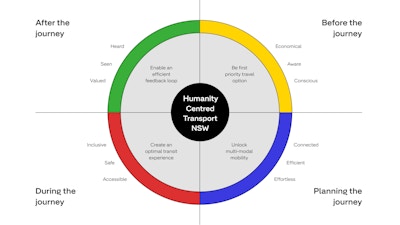How to use prototype thinking and experimentation to fall in love with the problem, not the ideas
We’re living in uncertain times. Innovation is changing the world faster each day, to the point it’s hard to keep up. All this change is great for sparking new ideas, but falling in love with your idea is a great way to fail fast.

Contact info for Jake Carroll
Principal Consultant
Contact info for Sheree Hannah
UX Design Lead
Falling in love with the problem you are trying to solve, however, gives you the freedom to try many ideas in your pursuit to serve your customers. But how do you try out so many ideas?
You need to think in prototypes.
There’s a misconception that a prototype needs to be a working product that users can test, but it’s nothing more than a way to get more information. A way to prove (or disprove) an assumption or hypothesis early so you can build further or pivot quickly to a new idea.
Here’s how you can think in prototypes.
Start with humanity-centred needs
Talk to your ideal customer. What problems are they facing? What behaviours do they have? What pain points stand in their way of accomplishing their goals?
Once you understand their needs, you can ideate various ways to solve for them and design for the outcomes you’re trying to attain.
Shape experiments around outcomes, not output
It’s common to make assumptions about what your customers need, but it’s important to prove your assumptions by experimenting around outcomes, not outputs.
Outcomes are the desired result you’re looking for. On the business side, it’s increased revenue, engagement, and user acquisition. On the consumer side, it’s increased utility, empowerment, and delight.
Outputs are the tangible deliverable you create to pursue your desired result.
When you focus your efforts on the desired result, you can focus more flexibly on what matters in your experimentation.
Reinforce learnings through rapid iteration and feedback loops
Experimenting doesn’t mean anything without learning and iterating.
The faster you can learn and make a decision accordingly, the quicker you’ll iterate your way to your desired outcome.
Ask yourself, what’s the quickest, cheapest way you can validate your assumptions or hypotheses? How can you get feedback from your customers quickly and consistently?
Whether it’s social media, surveys, or user calls, the key is to find easy ways to listen.
When you listen, you can act fast and iterate with intention.
Case study for transportation in New South Wales
Innovation brings new ideas, products, and services, but the most successful ideas thrive through experimentation.
Take the future of transportation in Australia. In our mission to shift towards more sustainable and humanity-centred transport options, we put together a framework and series of concepts for the Transport for NSW Innovation and Technology Showcase event.
To remain focused on the problem and not fall in love with our ideas, we created a lens by which we see that problem, which we’re calling Humanity Centred Transport.

The framework: Humanity Centred Transport
Humanity Centred Transport is about creating a system that prioritises commuter needs at each step of their journey and defining success based on desired outcomes rather than outputs.
Before the journey
Initiating the user journey, focusing on creating awareness and conscious decision-making before the journey begins.
- Business outcome: Be the first priority travel option.
- User outcome: How might you ensure riders feel economically aware and sustainably conscious?
- Concept: Carbon footprint comparison app to educate users about the environmental impact of different travel options and promote sustainable choices.
Success may look like:
- Increase the percentage of riders actively choosing public or sustainable transportation options over private car use.
- Positive feedback and user engagement with the carbon footprint comparison app.
- Reduction in carbon emissions per capita due to increased adoption of sustainable transportation.
Planning the journey
Assisting users in planning their journey by providing seamless and efficient multi-modal options.
- Business outcome: Unlock multi-modal mobility.
- User outcome: How might you make the journey feel connected, efficient, and effortless for riders?
- Concept: First mile, last mile travel planning platform to combine public transport schedules, bike-sharing availability, and ride-sharing services for optimal route planning.
Success may look like:
- Decrease average travel time and wait time for multi-modal journeys.
- Increase usage of integrated travel planning platforms for route optimisation.
- Positive user feedback on switching between different modes of transportation.
During the journey
Focusing on enhancing the actual travel experience for users during their journey.
- Business outcome: Create an optimal transit experience.
- User outcome: How might you make transport feel inclusive, safe, and accessible for riders?
- Concept: Upgraded transport app with features like real-time accessibility information, inclusive facilities, and notifications for crowded periods.
Success may look like:
- Improvement in accessibility ratings and increased satisfaction among users with specific accessibility needs.
- Decrease in safety-related incidents and increase in users' perception of safety during their journey.
- Positive feedback on the availability of inclusive facilities and features within the transport app.
After the journey
Engaging with users after their journey to gather feedback and improve the overall transportation system.
- Business outcome: Enable efficient feedback loop.
- User outcome: How might you help riders feel seen, heard, and valued?
- Concept: Integrated QR code and text-based feedback system for users to provide immediate input on their journey experience and suggest improvements.
Success may look like:
- Increase in the number of user feedback submissions and engagement with the feedback system.
- Timely responses and actions taken on user feedback demonstrating that users' opinions are valued and incorporated into improvements.
- Positive user sentiment and perception of being actively listened to and appreciated by the transportation system.
Experimentation is a game of strong opinions, loosely held. By prioritising outcomes and what success looks like, you can concept, test, and iterate your way to better ideas.
Need help thinking in prototypes? Let’s chat. Reach out to explore how we can help you experiment and push more ideas to the next level.